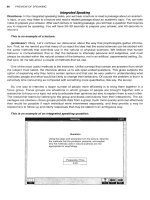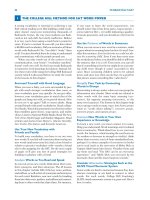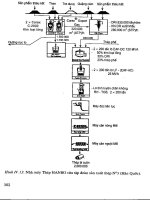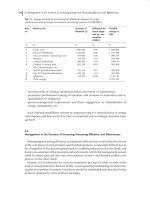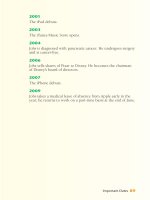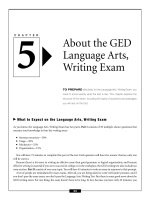The sat skill exam 10 pptx
Bạn đang xem bản rút gọn của tài liệu. Xem và tải ngay bản đầy đủ của tài liệu tại đây (192.18 KB, 6 trang )
■
In a square, diagonals have both the same length
and intersect at 90-degree angles.
Solid Figures, Perimeter,
and Area
The SAT will give you several geometrical formulas.
These formulas will be listed and explained in this sec-
tion. It is important that you be able to recognize the
figures by their names and to understand when to use
which formulas. Don’t worry. You do not have to mem-
orize these formulas. You will find them at the begin-
ning of each math section on the SAT.
To begin, it is necessary to explain five kinds of
measurement:
1. Perimeter. The perimeter of an object is simply
the sum of all of its sides.
2. Area. Area is the space inside of the lines defin-
ing the shape.
3. Volume. Volume is a measurement of a three-
dimensional object such as a cube or a rectangu-
lar solid. An easy way to envision volume is to
think about filling an object with water. The vol-
ume measures how much water can fit inside.
4. Surface Area. The surface area of an object meas-
ures the area of each of its faces. The total surface
area of a rectangular solid is the double the sum
of the areas of the three faces. For a cube, simply
multiply the surface area of one of its sides by 6.
5. Circumference. Circumference is the measure of
the distance around a circle.
Circumference
4
4
Surface area of front side = 16
Therefore, the surface area
of the cube = 16 ؋ 6 = 96.
= Area
6
7
4
10
Perimeter = 6 + 7 + 4 + 10 = 27
B
C
A
D
AC = DB
and
AC DB
–THE SAT MATH SECTION–
137
5658 SAT2006[04](fin).qx 11/21/05 6:44 PM Page 137
Formulas
The following are formulas that will be given to you on the SAT, as well as the definitions of variables used.
Remember, you do not have to memorize them.
Circle
Rectangle Triangle
r
l
w
h
b
A = lw
C = 2πr
A = πr
2
Cylinder
Rectangle
Solid
h
l
V = πr
2
h
w
r
h
V = lwh
C = Circumference
A = Area
r = Radius
l = Length
w = Width
h = Height
V = Volume
b = Base
A
=
1
2
bh
–THE SAT MATH SECTION–
138
5658 SAT2006[04](fin).qx 11/21/05 6:44 PM Page 138
Coordinate Geometry
Coordinate geometry is a form of geometrical opera-
tions in relation to a coordinate plane. A coordinate
plane is a grid of square boxes divided into four quad-
rants by both a horizontal (x) axis and a vertical (y) axis.
These two axes intersect at one coordinate point, (0,0),
the origin.A coordinate point, also called an ordered
pair, is a specific point on the coordinate plane with the
first point representing the horizontal placement and
the second point representing the vertical. Coordinate
points are given in the form of (x,y).
Graphing Ordered Pairs
THE X-COORDINATE
The x-coordinate is listed first in the ordered pair and
it tells you how many units to move to either the left or
to the right. If the x-coordinate is positive, move to the
right. If the x-coordinate is negative, move to the left.
THE Y-COORDINATE
The y-coordinate is listed second and tells you how many
units to move up or down. If the y-coordinate is positive,
move up. If the y-coordinate is negative, move down.
Example:
Graph the following points: (2,3), (3,–2),
(–2,3), and (–3,–2)
Notice that the graph is broken up into four quad-
rants with one point plotted in each one. Here is a
chart to indicate which quadrants contain which
ordered pairs based on their signs:
Lengths of Horizontal and
Vertical Segments
Two points with the same y-coordinate lie on the same
horizontal line and two points with the same x-coordinate
lie on the same vertical line. The distance between a hor-
izontal or vertical segment can be found by taking the
absolute value of the difference of the two points.
Example:
Find the length of A
ෆ
B
ෆ
and B
ෆ
C
ෆ
.
| 2 – 7 | = 5 = AB
| 1 – 5 | = 4 = BC
Distance of Coordinate Points
To find the distance between two points, use this vari-
ation of the Pythagorean theorem:
d = ͙(x
2
– x
ෆ
1
)
2
+ (y
ෆ
2
+ y
1
)
2
ෆ
Example:
Find the distance between points (2,3) and
(1,–2).
(2,1)
(7,5)
C
BA
Sign of
Points Coordinates Quadrant
(2,3) (+,+) I
(–2,3) (–,+) II
(–3,–2) (–,–) III
(3,–2) (+,–) IV
II
I
III IV
(−2,3) (2,3)
(−3,−2)
(3,−2)
–THE SAT MATH SECTION–
139
5658 SAT2006[04](fin).qx 11/21/05 6:44 PM Page 139
d = ͙(1 – 2)
ෆ
2
+ (–2
ෆ
– 3)
2
ෆ
d = ͙(1 + –2
ෆ
)
2
+ (–
ෆ
2 + –3
ෆ
)
2
ෆ
d = ͙(–1)
2
+
ෆ
(–5)
2
ෆ
d = ͙1 + 25
ෆ
d = ͙26
ෆ
Midpoint
To find the midpoint of a segment, use the following
formula:
Midpoint x =
ᎏ
x
1
+
2
x
2
ᎏ
Midpoint y =
ᎏ
y
1
+
2
y
2
ᎏ
Example:
Find the midpoint of A
ෆ
B
ෆ
.
Midpoint x =
ᎏ
1+
2
5
ᎏ
=
ᎏ
6
2
ᎏ
= 3
Midpoint y =
ᎏ
2+
2
10
ᎏ
=
ᎏ
1
2
2
ᎏ
= 6
Therefore, the midpoint of A
ෆ
B
ෆ
is (3,6).
Slope
The slope of a line measures its steepness. It is found by
writing the change in y-coordinates of any two points
on the line, over the change of the corresponding
x-coordinates. (This is also known as rise over run.)
The last step is to simplify the fraction that results.
Example:
Find the slope of a line containing the points
(3,2) and (8,9).
ᎏ
9
8
–
–
2
3
ᎏ
=
ᎏ
7
5
ᎏ
Therefore, the slope of the line is
ᎏ
7
5
ᎏ
.
Note: If you know the slope and at least one point
on a line, you can find the coordinate point of other
points on the line. Simply move the required units
determined by the slope. In the example above, from
(8,9), given the slope
ᎏ
7
5
ᎏ
, move up seven units and to the
right five units. Another point on the line, thus, is
(13,16).
Important Information about Slope
■
A line that rises to the right has a positive slope
and a line that falls to the right has a negative
slope.
■
A horizontal line has a slope of 0 and a vertical
line does not have a slope at all—it is undefined.
■
Parallel lines have equal slopes.
■
Perpendicular lines have slopes that are negative
reciprocals.
(3,2)
(8,9)
(5,10)
Midpoint
(1,2)
B
A
(2,3)
(1,–2)
–THE SAT MATH SECTION–
140
5658 SAT2006[04](fin).qx 11/21/05 6:44 PM Page 140
Word Problems and Data Analysis
This section will help you become familiar with the
word problems on the SAT and learn how to analyze
data using specific techniques.
Translating Words into Numbers
The most important skill needed for word problems is
being able to translate words into mathematical oper-
ations. The following will assist you in this by giving
you some common examples of English phrases and
their mathematical equivalents.
■
“Increase” means add.
Example:
A number increased by five = x + 5.
■
“Less than” means subtract.
Example:
10 less than a number = x – 10.
■
“Times” or “product” means multiply.
Example:
Three times a number = 3x.
■
“Times the sum”means to multiply a number
by a quantity.
Example:
Five times the sum of a number and three =
5(x + 3).
■
Two variables are sometimes used together.
Example:
A number y exceeds five times a number x
by ten.
y = 5x + 10
■
Inequality signs are used for “at least” and “at
most,”as well as “less than” and “more than.”
Examples:
The product of x and 6 is greater than 2.
x × 6 > 2
When 14 is added to a number x, the sum is less
than 21.
x + 14 < 21
The sum of a number x and four is at least nine.
x + 4 ≥ 9
When seven is subtracted from a number x, the
difference is at most four.
x – 7 ≤ 4
Assigning Variables in Word Problems
It may be necessary to create and assign variables in a
word problem. To do this, first identify an unknown
and a known. You may not actually know the exact
value of the “known,”but you will know at least some-
thing about its value.
Examples:
Max is three years older than Ricky.
Unknown = Ricky’s age = x.
Known = Max’s age is three years older.
Therefore, Ricky’s age = x and Max’s age = x + 3.
Siobhan made twice as many cookies as Rebecca.
Unknown = number of cookies Rebecca made
= x.
Known = number of cookies Siobhan made = 2x.
Cordelia has five more than three times the
number of books that Becky has.
Unknown = the number of books Becky has = x.
Known = the number of books Cordelia has =
3x + 5.
Percentage Problems
There is one formula that is useful for solving the three
types of percentage problems:
When reading a percentage problem, substitute
the necessary information into the above formula based
on the following:
■
100 is always written in the denominator of the
percentage sign column.
# %
100
=
–THE SAT MATH SECTION–
141
5658 SAT2006[04](fin).qx 11/21/05 6:44 PM Page 141
■
If given a percentage, write it in the numerator
position of the number column. If you are not
given a percentage, then the variable should be
placed there.
■
The denominator of the number column repre-
sents the number that is equal to the whole, or
100%. This number always follows the word “of”
in a word problem.
■
The numerator of the number column represents
the number that is the percent.
■
In the formula, the equal sign can be inter-
changed with the word “is.”
Examples:
Finding a percentage of a given number:
What number is equal to 40% of 50?
Solve by cross multiplying.
100(x) = (40)(50)
100x = 2,000
ᎏ
1
1
0
0
0
0
x
ᎏ
=
ᎏ
2
1
,0
0
0
0
0
ᎏ
x = 20 Therefore, 20 is 40% of 50.
Finding a number when a percentage is given:
40% of what number is 24?
Cross multiply:
(24)(100) = (40)(x)
2,400 = 40x
ᎏ
2,
4
4
0
00
ᎏ
=
ᎏ
4
4
0
0
x
ᎏ
60 = x Therefore, 40% of 60 is 24.
Finding what percentage one number is of
another:
What percentage of 75 is 15?
Cross multiply:
15(100) = (75)(x)
1,500 = 75x
ᎏ
1,
7
5
5
00
ᎏ
=
ᎏ
7
7
5
5
x
ᎏ
20 = x Therefore, 20% of 75 is 15.
Ratio and Variation
A ratio is a comparison of two quantities measured in
the same units. It is symbolized by the use of a colon—x:y.
Ratio problems are solved using the concept of
multiples.
Example:
A bag contains 60 red and green candies. The
ratio of the number of green to red candies is 7:8.
How many of each color are there in the bag?
From the problem, it is known that 7 and 8
share a multiple and that the sum of their prod-
uct is 60. Therefore, you can write and solve the
following equation:
7x + 8x = 60
15x = 60
ᎏ
1
1
5
5
x
ᎏ
=
ᎏ
6
1
0
5
ᎏ
x = 4
Therefore, there are (7)(4) = 28 green candies
and (8)(4) = 32 red candies.
Variation
Variation is a term referring to a constant ratio in the
change of a quantity.
■
A quantity is said to vary directly with another if
they both change in an equal direction. In other
words, two quantities vary directly if an increase
# %
__ = ___
75 100
x15
# %
__ = ___
x 100
40
24
# %
__ = ___
50 100
40
x
–THE SAT MATH SECTION–
142
5658 SAT2006[04](fin).qx 11/21/05 6:44 PM Page 142

